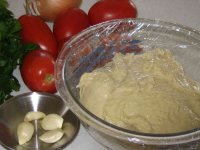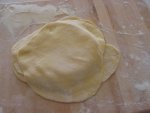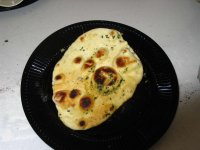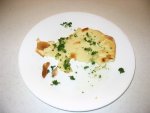Naan
This recipe is the result of quite a number of experimental batches using ideas found on the web and, of course, modeling it after that served at my local restaurant. Perserverance was necessary, but dipping hot out of the pan naan in my khurma recipe, will greatly improve the end product and it will get better as you gain more experience at it.
In fact, what I make here isn’t naan at all, but a chapati or roti because of how I’m able to cook it.
Naan is distinguished from roti by reason of being cooked in a tandoor and usually contains milk or yogurt. Because I’m trying to imitate naan, I use yogurt in this recipe.
Roti is a general term for bread cooked on a flat or slightly concave griddle called a tava. Paratha roti is made with ghee or oil rubbed on both sides, then fried in a tava becoming crisp.
Chapati is a roti used to eat curries and dahl.
Great YouTube coverage showing how to cook a roti: http://www.youtube.com/watch?v=Zg0p5TXi_Cc.
Also, http://wwww.ifood.tv/recipe/roti.
I have cooked this variously in a large, cast-iron skillet over a medium fire and on a stone in a very hot oven, 550°. There are advantages to both. The skillet cooks faster, but burns the bread very quickly. I still brush with vegetable or olive oil containing minced garlic and fresh-chopped parsley.
Serves 4-6.
Ingredients
| 2 cups | bread flour | |
| ½ tsp | salt | |
| 1 tsp | sugar | |
| 1½ tsp | baking powder | |
| ¼ tsp | baking soda | |
| 1 | egg, beaten | |
| ¼ cup | plain yogurt | |
| — | milk until good | |
| Garnish | ||
|---|---|---|
| — | olive oil | |
| 2 | cloves garlic, minced | |
| 2 tbsp | parsley, chopped | |
Preparation

1. Mix dry ingredients, then add yogurt, egg and water or milk until a soft dough is formed that is somewhat sticky. If dough is too dry, it will crack. Set aside for up to a few hours. (See image.) I’ve tried waiting a few hours and I’ve tried using it immediately: it’s just as good both ways and there is little perceptible difference.
2. Preheat a large-diameter cast-iron skillet to medium low or an oven stone to very hot, 550°.

3. Divide dough into 8 parts on floured surface. Flatten each piece out with a rolling pin or with your hands and fingers. The shape you are looking for is a tear drop (as if hung in a tandoor oven). Make it thin—1/8th of an inch—because it will puff up when cooking. You will need to flour your rolling pin and/or hands heavily to keep the dough from sticking. Having extra flour on the naan before and while baking does not seem to detract from the taste at all. If you ensure adequate flour between them, you can roll them all out and stack them a little ahead of time as shown here.

4. Place 1 or 2 pieces into the skillet or on a stone in an oven depending on what will fit. After a few seconds, flip with a spatula. Cook other side and remove from heat to a plate.
5. Brush with garnish if desired. Having minced the garlic and soaked it in the oil for a few hours beforehand yields a nicer result. If you boil the whole garlic cloves before passing them through the press, the flavor is better still.

The naan can get crispy in the oven, but it tastes good. Cook for less time and add more sugar for browning if you don’t want this to happen.
6. Seve immediately with Jasmine rice as an accompaniment to a khurma or curry.